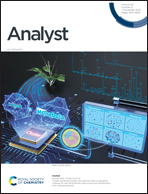Vapor detection and vapor pressure measurements of fentanyl and fentanyl hydrochloride salt at ambient temperatures†
Abstract
There is a need for non-contact, real-time vapor detection of drugs to combat illicit transportation and help curb the opioid epidemic. The low volatility of drugs, like fentanyl, makes room temperature vapor detection of illicit drugs challenging, but feasible by atmospheric flow tube-mass spectrometry (AFT-MS). AFT-MS is a non-contact vapor detection approach capable of ultra-trace detection of drugs, including fentanyl and its analogs at low parts-per-quadrillion (ppqv) levels. The determination of vapor pressure values of fentanyl is necessary to understand potential vapor concentrations that may be available for detection. In this paper, vapor pressures of fentanyl free base and fentanyl hydrochloride salt (a common form of the illicit drug) were measured as a function of temperature at or near ambient conditions using the transpiration (gas saturation) method and AFT-MS. Based on our measurements, the vapor pressure of fentanyl at 25 °C is 9.0 × 10−14 atm (90 ppqv), and the vapor pressure of fentanyl hydrochloride at 25 °C is 1.8 × 10−17 atm (0.018 ppqv). We also demonstrate non-contact, real-time vapor detection of fentanyl. Preconcentration of vapors can further extend the detection capabilities. The collection, desorption, and detection of fentanyl vapors at ambient conditions was demonstrated for sampling times of seconds to an hour resulting in increased signal. AFT-MS is a viable detection method of fentanyl and other drugs for screening of packages and cargo.



 Please wait while we load your content...
Please wait while we load your content...